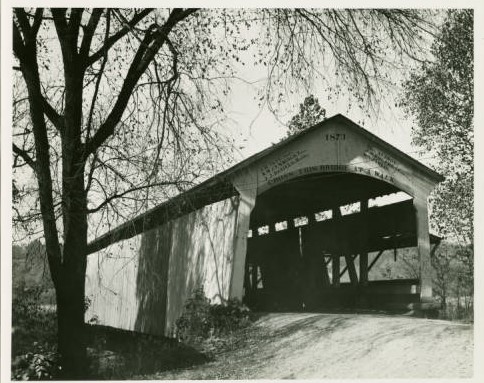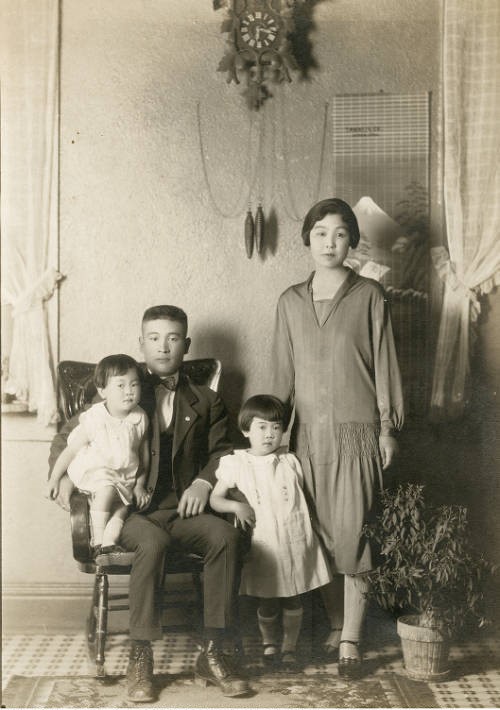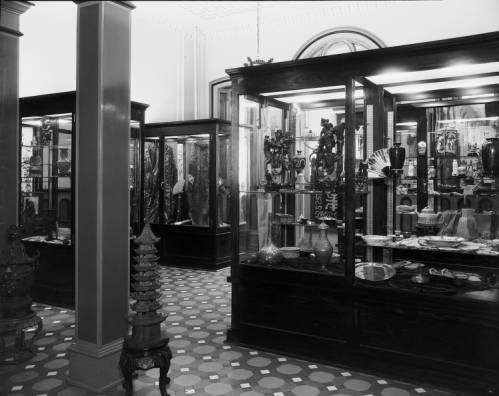
Purchase Tickets
Why is there a China, Indiana? (And Other Questions Answered)
February 1, 2024

Fans of the IHS blog may remember that last year, I published a blog about Mexico, Indiana and Latin American place names in the state. The research for that blog also piqued my interest to look at places and names that were inspired by the cities and countries of Asia.
Examining the time in which these place names were formed gives us some possible insight into their origins. Some place names derive their inspiration from the Bible or ancient history. But why China, Indiana? We know that it was established in Jefferson County in 1833, and presently it is an unincorporated area. It was not founded by or settled by anyone of Chinese descent or anyone with an interest in the country. China, Indiana was named after either the presence of the Chinaberry tree or a man with the last name of Chine. Exposure to East Asian culture and its peoples during the 19th century would have been through secondhand personal accounts of those involved in the merchant trade industry or those who were Christian missionaries, whose personal accounts were printed in local newspapers, magazines, and books.
What did people of Indiana know or read about Asia in the 19th Century? Was there an Asian population in Indiana? Information on U.S. Decennial census did not collect national origin numbers or ethnicity data until 1850. Since the first census in 1790, racial or ethnic indicators were listed as white, colored, mulatto, slave, or free. Indigenous populations had a separate census but were infrequently included on the main census. The first wave of Asian immigration to the United States began in the late 1810s and was mostly Chinese. The second wave in the mid-1800s was much larger. This group of Chinese immigrants was the largest group of non-Europeans to migrate to the United States since the era of the Atlantic slave trade. This demographic shift prompted the change in census data collection. The 1850 census asked questions about nativity or country of origin (national origin numbers), but in 1870 “Chinese” was newly added as a racial identifier and in 1890 “Japanese” was also added. Many of the early Chinese immigrants were merchants, but they notably took part in the Gold Rush on the West Coast and played a significant role in the expansion and continuation of the transcontinental railroad. Indiana saw the growth of the early East Asian population in the late 19th Century. Some Indianapolis notables of that era were Moy Kee (Chinese) and Ikko Matsumoto (Japanese).

Mary Yukiko Namba (later Watanabe) is pictured with her younger sister and parents. Her father Usaburo worked for the Union Pacific Railroad. He passed away a few years after this photo was taken. Mary would later marry Frank Hiroshi Watanabe in 1940. After the birth of their first child, a son names August in 1941, they would move to Berne, Indiana to grow and raise their family. Margaret R. Watanabe Family Photographs, IHS 2017.0323
Early American travelers to Asian countries were involved with the merchant trade or as religious missionaries. Trade with China began in the 1780s, with American exports of fur, sandalwood, and ginseng. The United States imported silk, teas, spices, furniture, fine china, and porcelain. Some of these luxury imports of course made their way to Indiana. Another American export to China was Christianity, with religious missionaries making their way throughout the country. The first American Christian missionary in Asia arrived in the early 1800s, and Christian preaching and proselytizing lasted until the start of the First Opium War (1839-1842.) During this war, Christianity was banned in China. After the war and the signing of the Treaty of Wangxia (1844), Christian missionaries, per treaty agreements, could return to China. The Indianapolis Journal newspaper wrote about a few Indiana Presbyterian ministers giving lectures about their missionary years in China. One 1885 lecture was given by Rev. Dr. O. P. Happer (Second Presbyterian) who was engaged in missionary work in China from 1844-1885. Coverage of his lecture noted two Chinese Presbyterian congregants in attendance. Later in 1890 the Indianapolis Journal reported on the homecoming of Rev. Albert A. Fulton and Mrs. Fulton, First Presbyterian missionaries who met and married in China. They spent nine years abroad and when they returned to Indianapolis a party was prepared in their honor at the home of Mr. D.L. Whittier at 294 N. Meridian Street. The paper reported that amongst those attending was “three little kinsfolk born in China, and who speak the tounge Celestial even better than they do English”.

Artifacts on display may be associated with St. Mary of the Woods College and Sister of Providence mission to Kaifeng, China, in the 1920s. Martin’s Photo Shop Collection photograph, 1906-1976
The geography of present-day Asia is broad, with almost 50 countries that cover six geographic regions: Central Asia, East Asia, North Asia, Southeast Asia, South Asia, and West Asia. Some of these regionally Asian countries or their cities are on this list.
B
Bengal – A post office was established in 1881, but this Shelby County town, named after the state (before the British partition in 1905) in present-day India, was never platted.
Buddha (Flynn’s Crossroads) – A post office was established in 1895, first named Flynn’s Crossroads. This Lawrence County location has no connection to the 6th-century South Asian religious teacher. Instead, it is rumored it was named after a transient traveler with the nickname of Buddha or shorthand for the Hungarian city, Budapest.
C
China (Indiana Kentucky) – Before the post office was established in 1833, it was called Indiana Kentucky. It was renamed China in 1833 for the East Asian country. China is in Jefferson County.
H
Hindustan (formerly Hindostan) – A Monroe County village platted in 1853 and named after the northern region of the South Asian country of India. Hindustan is also the Persian name for India.
L
Lebanon – Platted in 1832, early white settlers in Boone County named this city after Mount Lebanon, as the tall hickory trees on the prairie reminded them of the place described in the Bible known for its cedar forest. Mount Lebanon is in present-day West Asia, in the country of Lebanon.
M
Manilla (Wilmington) – Originally settled in 1824 and laid or platted out in 1836 and named for the hometown of its original white settlers, Wilmington, North Carolina, this Rush County town was later renamed after a city in the Southeast Asian country the Philippines. Unsure of the year of name change. If it was after 1898, this would have been inspired by the Spanish-American War.
Mecca (Mecca Hills) – This Parke County village was platted in 1890, where there was a church that was nicknamed “The Arabian Church”, due to its location on a dry and sandy hill. Roads were often flooded and were only passable in the spring months. Local store owner, Alexander McCune compared folks returning to the area in the spring to the annual Muslim religious pilgrimage to the holy city of Mecca, the birthplace of Prophet Muhammad and Islam. In 1898, a tile plant was built there and reportedly recruited foreign laborers from West Asia, the Middle East.
N
New Lebanon – Settled in 1827 by Methodists, named after Mount Lebanon, mentioned in the Bible. Since there was already another Indiana city by the name of Lebanon, the word “New” was later added. A post office was established in this Sullivan County town in 1836. (see Lebanon)
New Palestine – It was laid out in 1838. The first post office was known as Sugar Creek and the railroad station was known as New Palestine, due to other areas with the name of Palestine. The official name of this Hancock County city changed in 1889. (see Palestine).
New Pekin – Located in Washington County, this town was established in 1852 as a railroad station near the village of Pekin. Pekin is an East Asian city in China, now present-day Beijing. (see Pekin).
P
Palestine (Tipicanuk) – A post office was established in 1830 at this Kosciusko County location and was originally called Tipicanunk, a variation of Tippecanoe. It was renamed Palestine in 1839, derived from biblical inspiration. The State of Palestine is in West Asia, the Middle East.
Palestine (Wynn)- A Franklin County village presently known as Wynn, the town was platted in 1847, and a post office was established in 1848. The town was originally named Palestine, derived from biblical inspiration. The State of Palestine is in West Asia, the Middle east. The town was renamed Wynn to differentiate itself from another town of the same name (see Palestine).
Palmyra (McCallan’s Crossroads/Carthage) – Founded in 1810 and named McCallan Crossroads after Hays McCallan. In 1836 it was renamed Carthage. Later in 1839 as the Harrison County town began to expand, the name was changed to Palmyra, the ancient city built by Solomon, which is in the present-day West Asian, Middle Eastern country of Syria.
Pekin- This Washington County town was laid out in 1831 and named for the city in the Eastern Asian country, China. Pekin is now present-day Beijing.
S
Samaria (Newburg) – Originally platted in 1852 as Newburg, this Johnson County town was renamed Samaria after the biblical city, which is in the present-day West Asian, Middle Eastern country, Israel.
Shanghai – A post office was established in this Howard County village in 1858. It is rumored that it was named after the chicken breed that lived here and not the city in China.
Smyrna- The first post office was established in this Decatur County town in 1846. It was named after a historic ancient port city, and the birthplace of Homer, the 8th-century author of the Iliad and the Odyssey. Biblically, it is one of the seven cities mentioned by John the Apostle in the Book of Revelation. Presently it is known as Izmir in the West Asian, Middle Eastern country, Turkey. Smyrna is a popular town name across the United States.
Syria – A post office was established in this village in 1880. This Orange County town was named after the Western Asian, Middle Eastern country of the same name.
Y
Yeddo – In 1881 this Fountain County village was platted, and a post office was established. Yedo, Yeddo, or Jeddo is the anglicization of the port city, Edo, located in the East Asian country, Japan. In 1868, Edo (Japan) was renamed Tokyo.








